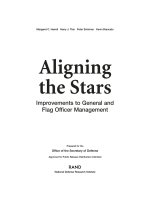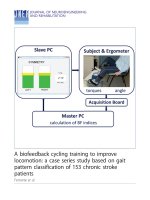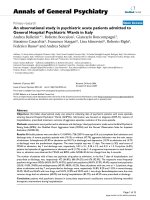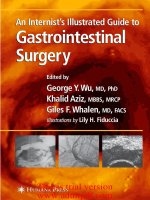First exposure to general surgery first exposure series
Bạn đang xem bản rút gọn của tài liệu. Xem và tải ngay bản đầy đủ của tài liệu tại đây (4.67 MB, 434 trang )
FIRST EXPOSURE TO
GENERAL SURGERY
Danny O. Jacobs, MD, MPH
Professor and Chairman
Department of Surgery
Duke University School of Medicine
Durham, North Carolina
McGRAW-HILL
MEDICAL PUBLISHING DIVISION
New York / Chicago / San Francisco / Lisbon / London / Madrid / Mexico City
Milan / New Delhi / San Juan / Seoul / Singapore / Sydney / Toronto
Copyright © 2007 by The McGraw-Hill Companies, Inc. All rights reserved. Manufactured in the United
States of America. Except as permitted under the United States Copyright Act of 1976, no part of this
publication may be reproduced or distributed in any form or by any means, or stored in a database or
retrieval system, without the prior written permission of the publisher.
0-07-149129-5
The material in this eBook also appears in the print version of this title: 0-07-144140-9.
All trademarks are trademarks of their respective owners. Rather than put a trademark symbol after every
occurrence of a trademarked name, we use names in an editorial fashion only, and to the benefit of the
trademark owner, with no intention of infringement of the trademark. Where such designations appear in
this book, they have been printed with initial caps.
McGraw-Hill eBooks are available at special quantity discounts to use as premiums and sales promotions,
or for use in corporate training programs. For more information, please contact George Hoare, Special
Sales, at or (212) 904-4069.
TERMS OF USE
This is a copyrighted work and The McGraw-Hill Companies, Inc. (“McGraw-Hill”) and its licensors
reserve all rights in and to the work. Use of this work is subject to these terms. Except as permitted under
the Copyright Act of 1976 and the right to store and retrieve one copy of the work, you may not decompile, disassemble, reverse engineer, reproduce, modify, create derivative works based upon, transmit, distribute, disseminate, sell, publish or sublicense the work or any part of it without McGraw-Hill’s prior consent. You may use the work for your own noncommercial and personal use; any other use of the work is
strictly prohibited. Your right to use the work may be terminated if you fail to comply with these terms.
THE WORK IS PROVIDED “AS IS.” McGRAW-HILL AND ITS LICENSORS MAKE NO GUARANTEES OR WARRANTIES AS TO THE ACCURACY, ADEQUACY OR COMPLETENESS OF OR
RESULTS TO BE OBTAINED FROM USING THE WORK, INCLUDING ANY INFORMATION THAT
CAN BE ACCESSED THROUGH THE WORK VIA HYPERLINK OR OTHERWISE, AND EXPRESSLY DISCLAIM ANY WARRANTY, EXPRESS OR IMPLIED, INCLUDING BUT NOT LIMITED TO
IMPLIED WARRANTIES OF MERCHANTABILITY OR FITNESS FOR A PARTICULAR PURPOSE.
McGraw-Hill and its licensors do not warrant or guarantee that the functions contained in the work will
meet your requirements or that its operation will be uninterrupted or error free. Neither McGraw-Hill nor
its licensors shall be liable to you or anyone else for any inaccuracy, error or omission, regardless of cause,
in the work or for any damages resulting therefrom. McGraw-Hill has no responsibility for the content of
any information accessed through the work. Under no circumstances shall McGraw-Hill and/or its
licensors be liable for any indirect, incidental, special, punitive, consequential or similar damages that
result from the use of or inability to use the work, even if any of them has been advised of the possibility
of such damages. This limitation of liability shall apply to any claim or cause whatsoever whether such
claim or cause arises in contract, tort or otherwise.
DOI: 10.1036/0071441409
Professional
Want to learn more?
We hope you enjoy this
McGraw-Hill eBook! If
you’d like more information about this book,
its author, or related books and websites,
please click here.
To all students of surgery and we honor those
who have taught us.
This page intentionally left blank
For more information about this title, click here
C O N T E N T S
Contributors
Preface
Acknowledgments
SECTION I
Chapter 1
Chapter 2
Chapter 3
Chapter 4
Chapter 5
Chapter 6
Chapter 7
SECTION II
Chapter 8
Chapter 9
Chapter 10
vii
xi
xii
FUNDAMENTAL PRINCIPLES
Preoperative Assessment and Preparation
Sandhya Lagoo-Deenadayalan, MD, PhD
Traumatic Injury
Kumash R. Patel, MD
Steven N. Vaslef, MD, PhD
Surgical Infection
Wendy R. Cornett, MD
The Acute Abdomen
C. Denise Ching, MD
Aurora D. Pryor, MD
The Operating Room
L. Scott Levin, MD, FACS
The Postoperative Care of the Surgical Patient
Philip Y. Wai, MD
Paul C. Kuo, MD, MBA
Rebecca A. Schroeder, MD
Wound Healing and Wound Management
Detlev Erdmann, MD, PhD
Tracey H. Stokes, MD
COMMON SURGICAL DISEASES
Esophagus
Shu S. Lin, MD, PhD
Stomach
Carlos E. Marroquin, MD
Intestine & Colon
Rebekah R. White, MD
Danny O. Jacobs, MD, MPH
v
1
3
23
59
69
85
91
121
137
139
169
196
vi
CONTENTS
Chapter 11
Chapter 12
Chapter 13
Chapter 14
Chapter 15
Chapter 16
Chapter 17
SECTION III
Chapter 18
Index
Hepatobiliary Surgery
David Sindram, MD, PhD
Janet E. Tuttle-Newhall, MD
Pancreas
Bradley H. Collins, MD, FACS
Spleen
Dev M. Desai, MD, PhD
Breast Reconstruction
Michael R. Zenn, MD, FACS
Endocrine Surgery
Jennifer H. Aldrink, MD
John A. Olson, Jr., MD, PhD
Hernias
Keshava Rajagopal, MD, PhD
Head and Neck Surgery Reconstruction
Steffen Baumeister, MD
L. Scott Levin, MD, FACS
FUNDAMENTAL PROCEDURES
Fundamental Procedures
Jose L. Trani Jr., MD
Matthew G. Hartwig, MD
Brian Lima, MD
Mayur B. Patel, MD
Jacob N. Schroder, MD
Tamarah J. Westmoreland, MD
Rebecca P. Petersen, MD, MSc
Anthony Lemaire, MD
Jin S. Yoo, MD
214
234
267
282
294
319
341
369
371
411
C O N T R I B U T O R S
Dev M. Desai, MD, PhD
Assistant Professor of Surgery
Division of General Surgery
Department of Surgery
Duke University Medical Center
Durham, North Carolina
Chapter 13
Jennifer H. Aldrink, MD
General Surgery Resident
Department of Surgery
Duke University Medical Center
Durham, North Carolina
Chapter 15
Steffen Baumeister, MD
Research Fellow
Division of Plastic, Reconstructive,
Maxillofacial and Oral Surgery
Department of Surgery
Duke University Medical Center
Durham, North Carolina
Chapter 17
Detlev Erdmann, MD, PhD
Assistant Professor of Surgery
Division of Plastic, Reconstructive,
Maxillofacial and Oral Surgery
Department of Surgery
Duke University Medical Center
Durham, North Carolina
Chapter 7
C. Denise Ching, MD
General Surgery Resident
Department of Surgery
Duke University Medical Center
Durham, North Carolina
Chapter 4
Matthew G. Hartwig, MD
General Surgery Resident
Department of Surgery
Duke University Medical Center
Durham, North Carolina
Chapter 18
Bradley H. Collins, MD, FACS
Assistant Professor of Surgery
Division of General Surgery,
Transplantation
Department of Surgery
Duke University Medical Center
Durham, North Carolina
Chapter 12
Danny O. Jacobs, MD, MPH
Professor and Chairman
Department of Surgery
Duke University School
of Medicine
Durham, North Carolina
Paul C. Kuo, MD, MBA
Professor and Chief
Division of General Surgery
Department of Surgery
Duke University Medical Center
Durham, North Carolina
Chapter 6
Wendy R. Cornett, MD
Assistant Professor of Surgery
Department of Surgery
Medical University of South Carolina
Charleston, South Carolina
Chapter 3
vii
Copyright © 2007 by The McGraw-Hill Companies, Inc. Click here for terms of use.
viii
Sandhya Lagoo-Deenadayalan,
MD, PhD
Assistant Professor of Surgery
Department of Surgery
Duke University Medical Center
Durham, North Carolina
Chapter 1
Anthony Lemaire, MD
General Surgery Resident
Department of Surgery
Duke University Medical Center
Durham, North Carolina
Chapter 18
L. Scott Levin MD, FACS
Professor and Chief
Division of Plastic/Reconstructive/
Oral Surgery
Professor of Orthopaedic Surgery
Duke University Medical Center
Durham, North Carolina
Chapter 5, 17
Brian Lima, MD
General Surgery Resident
Department of Surgery
Duke University Medical Center
Durham, North Carolina
Chapter 18
Shu S. Lin, MD, PhD
Assistant Professor of Surgery
Division of Thoracic and
Cardiovascular Surgery
Department of Surgery
Duke University Medical Center
Durham, North Carolina
Chapter 8
CONTRIBUTORS
Carlos E. Marroquin, MD
Assistant Professor of Surgery
Department of Surgery
Duke University Medical Center
Durham, North Carolina
Chapter 9
John A. Olson, Jr., MD, PhD
Associate Professor of Surgery
Division of General Surgery
Department of Surgery
Duke University Medical Center
Durham, North Carolina
Chapter 15
Kumash R. Patel, MD
Assistant Professor of Surgery
Department of Surgery
Tulane University Hospital
New Orleans, LA
Chapter 2
Mayur B. Patel, MD
General Surgery Resident
Department of Surgery
Duke University Medical Center
Durham, North Carolina
Chapter 18
Rebecca P. Petersen, MD, MSc
General Surgery Resident
Department of Surgery
Duke University Medical Center
Durham, North Carolina
Chapter 18
Aurora D. Pryor, MD
Assistant Professor of Surgery
Division of General Surgery
Department of Surgery
Duke University Health System
Durham, North Carolina
Chapter 4
CONTRIBUTORS
Keshava Rajagopal, MD, PhD
General Surgery Resident
Department of Surgery
Duke University Medical Center
Durham, North Carolina
Chapter 16
Jacob N. Schroder, MD
General Surgery Resident
Department of Surgery
Duke University Medical Center
Durham, North Carolina
Chapter 18
Rebecca A. Schroeder, MD
Associate Professor
Department of Anesthesiology
Durham Veterans Affairs
Medical Center
Chapter 6
David Sindram, MD, PhD
General Surgery Resident
Department of Surgery
Duke University Medical Center
Durham, North Carolina
Chapter 11
Tracey H. Stokes, MD
Chief Resident in Plastic Surgery
Division of Plastic, Reconstructive,
Maxillofacial and Oral Surgery
Department of Surgery
Duke University Medical Center
Durham, North Carolina
Chapter 7
Jose L. Trani, Jr., MD
General Surgery Resident
Department of Surgery
Duke University Medical Center
Durham, North Carolina
Chapter 18
ix
Janet E. Tuttle-Newhall, MD
Assistant Professor of Surgery
Division of General Surgery/
Transplant Surgery/Critical Care
Department of Surgery
Duke University Medical Center
Durham, North Carolina
Chapter 11
Steven N. Vaslef, MD, PhD
Associate Professor of Surgery
Director, Trauma Services and
Chief, Section of Trauma and
Critical Care
Division of General Surgery
Department of Surgery
Duke University Medical Center
Durham, North Carolina
Chapter 2
Philip Y. Wai, MD
General Surgery Resident
Yale School of Medicine
New Haven, Connecticut
Chapter 6
Tamarah J. Westmoreland, MD
General Surgery Resident
Department of Surgery
Duke University Medical Center
Durham, North Carolina
Chapter 18
Rebekah R. White, MD
Surgical Oncology Fellow
Memorial Sloan-Kettering
Cancer Center
New York, New York
Chapter 10
x
Jin S. Yoo, MD
General Surgery Resident
Department of Surgery
Duke University Medical Center
Durham, North Carolina
Chapter 18
CONTRIBUTORS
Michael R. Zenn, MD, FACS
Associate Professor
Division of Plastic/Reconstructive
Oral Surgery
Department of Surgery
Duke University Medical Center
Durham, North Carolina
Chapter 14
P R E F A C E
We have endeavored to prepare a concise “mini-textbook” that would be
most useful for medical students as they begin their first clinical rotations on
general surgery services. Our goal was to present the material as succinctly
as possible while emphasizing the fundamental principles relevant to each
topic area. We asked ourselves, what do we wish had been written in the
texts we read as medical students and used the answers to these questions
to guide our efforts.
Danny O. Jacobs, MD, MPH
xi
Copyright © 2007 by The McGraw-Hill Companies, Inc. Click here for terms of use.
A C K N O W L E D G M E N T S
We’d like to thank Michelle Fisher for her many contributions that helped to
make “First Exposure to Surgery” possible.
xii
Copyright © 2007 by The McGraw-Hill Companies, Inc. Click here for terms of use.
S E C T I O N
I
FUNDAMENTAL
PRINCIPLES
Copyright © 2007 by The McGraw-Hill Companies, Inc. Click here for terms of use.
This page intentionally left blank
C H A P T E R
1
PREOPERATIVE
ASSESSMENT AND
PREPARATION
Sandhya Lagoo-Deenadayalan, MD, PhD
INTRODUCTION
The aim of a preoperative evaluation of a patient is to assess the fitness of the
individual for anesthesia and surgery. Given a choice of any one test for preoperative assessment of a patient, a thorough history and physical examination will be the test of choice. This time—honored and inexpensive test can
account for more than two-thirds of all diagnoses made and should direct all
preoperative testing.
A well-conducted history and physical examination answer several
important questions:
•
•
•
•
•
•
Is this a healthy patient?
What is the indication for surgery?
Is the surgical procedure low risk, intermediate risk, or high risk?
What is the functional status of the patient?
What is the effect of the present condition on the patient?
What improvement is expected after surgery?
Answers to these questions should then direct preoperative testing and
management.1 Preoperative tests rarely detect unsuspected medical conditions. The tests selected should therefore evaluate existing illness, screen for
conditions that could affect outcomes in the perioperative period, and help
to determine perioperative risks. Existing illnesses that need evaluation and
possible treatment prior to surgery include hypertension, diabetes mellitus,
cardiac, vascular, pulmonary, renal, and hepatic diseases. The pregnant
3
Copyright © 2007 by The McGraw-Hill Companies, Inc. Click here for terms of use.
4
SECTION I
patient, the geriatric patient, the patient with oncologic disease, malnutrition, or coagulation disorders also needs directed evaluations.
THE HEALTHY PATIENT
The initial preoperative evaluation of a patient should be supplemented by a
complete assessment of the patient’s general health. This involves a thorough
history and physical examination. Complete blood counts should be obtained
in all adult women, men over 60 years of age, and patients with hematologic
disorders. Blood urea and electrolytes should be tested in all patients over
60 years of age, and in patients with known cardiovascular and renal disease,
diabetes, and in patients on steroids, diuretics, and angiotensin-converting
enzyme (ACE) inhibitors. An electrocardiogram (ECG) is indicated in men
over 40 years, women over 50 years, and in patients with cardiovascular
diseases and diabetes. Posteroanterior and lateral chest x-rays are indicated
in patients with cardiovascular and respiratory diseases, in patients with
malignancy, and those undergoing major thoracic or abdominal surgery.2
A history of the current diagnosis and the planned procedure should be
obtained. The history should include information regarding any known
medical problems and ongoing treatment, previous surgical procedures, and
problems if any during previous anesthesia. These can include difficult intubation, bleeding tendencies, and anesthetic jaundice. Family history of problems during anesthesia or surgery should be obtained. These can make the
anesthesiologist aware of potential problems such as malignant hyperthermia, bleeding tendencies, or thrombophilia. In addition to routine information about family history, a strong family history of allergies should alert the
surgeon to the possibility of hypersensitivity to drugs.
An exhaustive history of drug allergies, sensitivities, and current or
recently taken medications should be obtained. Medications such as digitalis, insulin, and corticosteroids should be maintained and their doses carefully regulated in the perioperative period. If the patient is on corticosteroids
or if it has been discontinued within a month of surgery, he or she may have
a hypofunctioning adrenal cortex resulting in impaired physiologic response
to surgical stress. This may necessitate administration of steroids in the perioperative period. Long-term use of barbiturates, opiates, and alcohol may be
associated with increased tolerance to anesthetic drugs. History of smoking
and alcohol use should be obtained. A review of constitutional symptoms—
fever, weight loss, heartburn, and regurgitation—is critical.
PHYSICAL EXAMINATION
A thorough physical examination should be conducted. Assessment of general appearance, vital signs, body mass index, jugular venous pressure and
pulsation, evaluation of the head and neck to gauge airway problems and
CHAPTER 1 / PREOPERATIVE ASSESSMENT AND PREPARATION
5
lack of supple neck movements, auscultation of the lung, precordial palpation and auscultation, abdominal inspection for scars from previous surgery
and abdominal palpation, examination of peripheral arterial pulses (carotid,
radial, femoral, popliteal, posterior tibial, and dorsalis pedis) and of the
extremities for edema are critical. Cyanosis, pallor, jaundice, dyspnea, nutritional status, skeletal deformity, and anxiety should be recognized. An
assessment of mental status and a brief neurologic examination should be
conducted. A rectal and pelvic examination should be performed unless contraindicated. Surgery-specific risk can be determined based on several criteria (Table 1-1).
Briefly, high-risk cases in which the incidence of morbidity and mortality
may be greater than 5 percent include aortic and major vascular procedures,
intra-abdominal resections, surgery with major fluid shifts, and gynecologic and oncology procedures. Intermediate-risk cases have a morbidity
of 1–5 percent and include head and neck resections, carotid endarterectomy, major orthopedic procedures, laparoscopic intra-abdominal procedures, and hysterectomy or radical prostatectomy. Low-risk cases include
most endoscopic procedures, breast surgery, ophthalmologic procedures,
and hernia repair.
Table 1-1 Surgery-specific Risk
High Risk >5%
Emergencies
Aortic and major vascular procedures
Major intra-abdominal resections
Surgery with major fluid shifts
Gynecologic and oncology procedures
Intermediate Risk 1–5%
Head and neck resections
Carotid endarterectomy
Major orthopedic procedures
Laparoscopic intra-abdominal procedure
Hysterectomy or radical prostatectomy
Low Risk
Endoscopic procedures
Breast surgery
Ophthalmologic procedures
Hernia repair
6
SECTION I
Table 1-2 ASA Classification
ASA Class
1
2
3
4
5
Description
No gross organic disease, healthy patient
Mild or moderate systemic disease without functional
impairment
Organic disease with definite functional impairment
Severe disease that is life threatening
Moribund patient, not expected to survive
Identification of functional status is a critical part of a preoperative evaluation and is accomplished during a physical examination. The American
Society of Anesthesiology (ASA) Physical Status Classification is a commonly used grading system that accurately correlates functional status with
morbidity and mortality following surgery (Table 1-2). ASA Class 1 indicates
a healthy patient with no gross organic disease. ASA Class 2 indicates a
patient with mild or moderate systemic disease without functional impairment, while ASA Class 3 indicates a patient with organic disease with definite functional impairment. A Class 4 patient is one with a severe disease that
is life threatening and a Class 5 patient is one who is moribund and has a
low likelihood of survival. Mortality is expected to be 0.05 percent in ASA
Class 1 patients, 0.4 percent in ASA Class 2 patients, 4.5 percent in ASA
Class 3 patients, 25 percent in Class 4 patients, and 50 percent in ASA Class 5
patients.
HYPERTENSION
Hypertension is a minor clinical predictor of increased preoperative cardiovascular risk. Hypertension is classified as primary (essential or idiopathic)
in 95 percent of cases. Secondary hypertension is found in 5 percent of
patients. The five most common causes of secondary hypertension include
renal artery stenosis, primary hyperaldosteronism, Cushing syndrome,
pheochromocytoma, and aortic stenosis. Several studies have suggested that
intraoperative blood pressure changes may be greater in untreated hypertensive patients. Patients are therefore advised to take their antihypertensive
medications on the day of surgery, with the exception of diuretics. These are
withheld to avoid hypovolemia or hypokalemia.
Application of ASA grading to hypertensive disease classifies those
patients with well-controlled hypertension on a single agent as ASA Class 2
CHAPTER 1 / PREOPERATIVE ASSESSMENT AND PREPARATION
7
patients and those patients with poorly controlled hypertension and on multiple drugs as ASA Class 3 patients. Elegant studies by Goldman3 revealed
that elective surgery in patients with inadequately controlled hypertension
was not associated with increased risk of perioperative cardiac morbidity
provided the diastolic blood pressure was less than 110 mmHg and perioperative blood pressure was closely monitored. Discontinuation of antihypertensive therapy can be dangerous. Examples include rebound hypertension
after discontinuation of a centrally acting α2-adrenergic agonist such as
clonidine or congestive heart failure (CHF) in the perioperative period after
withholding ACE inhibitors. β-Adrenergic blockade should be continued
throughout the preoperative period. Myocardial ischemia is associated with
tachycardia but not with acute changes in blood pressure. Beta-blockers such
as atenolol are found to be cardio protective. A study by Mangano and
Goldman4 has shown that beta-blockers given pre- and postoperatively can
reduce the risk of death in patients with known coronary artery disease
(CAD) or at risk for CAD. Contraindications to the use of beta-blockers
include a heart rate of less than 55, systolic blood pressure of less than 100,
bronchospasm, CHF, and patients with second- or third-degree heart
block. A recent myocardial infarction (MI) is the single most important factor that can predict perioperative infarction. The risk is greatest within the
first 3 months after an infarction. In a patient with a recent MI, elective
surgery should be postponed to after 6 months, when the risk of reinfarction
drops to 4.5 percent as opposed to 30 percent within 3 months. Urgent
surgery should be preceded by coronary artery bypass or stenting.
In cases of emergency surgery, uncontrolled hypertension should not be
a deterrent to proceeding with surgery. Short-acting beta-blockers can be
used to control hypertension in the perioperative period. Ketamine should
be avoided, as tachycardia, hypertension, and increased intracranial pressure are all associated with its use. Most importantly, perioperative treatment of hypertension with the parenterally administered drugs mentioned
earlier should be undertaken only after optimization of ventilation, oxygenation, and circulation in the patient.
CARDIAC DISEASE
A careful history and physical examination can shed light on risk factors for
coronary disease such as smoking, hypertension, diabetes, hypercholesterolemia, and a family history of CAD, valvular disease, CHF, arrhythmias,
cerebrovascular disease, and peripheral vascular disease. Clinical predictors,
cardiac risk for the procedure (Table 1-3), and functional status of the patient
should determine the need for preoperative cardiac workup.5
Perioperative cardiac and long-term risks are increased in patients
unable to meet a 4-MET demand. MET is a metabolic equivalent. Greater than
8
SECTION I
Table 1-3 Clinical Predictors of Increased Perioperative Cardiovascular Risk
Major Risk
Unstable coronary syndromes—recent MI, unstable angina
Decompensated CHF
Significant arrhythmias
Severe valvular disease
Intermediate Risk
Mild angina
Prior MI
Compensated CHF
Diabetes mellitus
Minor Risk
Advanced age
Abnormal ECG
Uncontrolled systemic hypertension
10 METs indicate an individual with excellent functional status, a patient
involved in competitive sports, aerobics, jogging, and so on. Between 4 and
10 METs indicates a patient who can climb one flight of steps, walk up a hill,
or walk a mile in 15 min. Less than 4 METs indicates a patient unable to meet
the above criteria. Stable angina with occasional use of nitroglycerin classifies a patient as an ASA Class 2 patient, whereas unstable angina or regular
use of nitroglycerin classifies a patient as ASA Class 3. Major clinical risk factors should be stabilized before surgery. This may require intervention such
as coronary angiography, angioplasty or stenting, or cardiac surgery.
Patients with intermediate clinical risk and poor functional capacity should
undergo noninvasive testing. Those with good functional capacity need
invasive testing only for high-risk procedures. Patients with minor or no
clinical risk and poor functional capacity need invasive testing only in case
of high-risk procedures. Those with good functional capacity can undergo
surgery without further testing.
New invasive studies are designed to determine the presence and severity of reversible ischemia induced by stress. The stress can be induced by
exercise or with drugs such as dobutamine or dipyridamole in patients who
cannot exercise. Test tools include ECG, echocardiography, and radionuclide
studies using thallium and/or sestamibi. Patients with low- or intermediate-risk
noninvasive testing can proceed with surgery, while those with high-risk
CHAPTER 1 / PREOPERATIVE ASSESSMENT AND PREPARATION
9
noninvasive testing should undergo coronary angiography and a revascularization procedure prior to noncardiac surgery. In high-risk cardiac
patients, perioperative hemodynamic monitoring is essential. This may
involve arterial lines and central venous lines or pulmonary artery catheters
that can help assess hemodynamic status. Such monitoring can help optimize perioperative volume resuscitation or restriction, diuretics, afterload
reduction, and the use of inotropic drugs.
PULMONARY DISEASE
An accurate preoperative prediction of pulmonary risk associated with
abdominal surgery is not well-defined. Clinical factors that have been shown
to be useful in the prediction of postoperative pulmonary complications
include a history of smoking, chronic bronchitis, airflow obstructions, obesity, and prolonged preoperative hospital stay. The presence of colonizing
bacteria in the stomach and the use of nasogastric intubation increase the
specific risk of postoperative pneumonia. Smaller incisions and the use of
laparoscopic techniques reduce the incidence of pulmonary complications
due to decreased postoperative pain and early ambulation. The most important predictive factors appear to be the overall condition of the patient
(based on the ASA classification) and patient age. Patients with controlled
cough or wheeze and asthma well controlled on inhalers belong to ASA
Class 2, and those with breathlessness on minor exertion, and poorly controlled asthma that limits lifestyle are considered ASA Class 3.
Early and late postoperative pulmonary complications were leading
causes of morbidity and mortality in surgery. A detailed history should be
obtained to evaluate the history of asthma, bronchospasm, duration of prior
asthma therapy, previous hospitalization, steroid use, and prior need for
mechanical ventilation. Elective surgery should be postponed in cases of
acute upper respiratory tract infections. Additional information regarding
smoking history (pack-years), nutritional status, concomitant heart disease,
and current therapy including home oxygen use should be sought. Physical
findings that suggest right ventricular failure include peripheral edema, a
prominent right ventricular impulse, or neck vein distention.
A preoperative chest radiograph helps to evaluate lung disease and
serves as a basis for comparison in the perioperative period. Significant airflow obstructions can be associated with a normal x-ray. Findings such as
depression of the right hemidiaphragm at or below the seventh rib in an
anteroposterior view, a cardiac silhouette with a transverse diameter of less
than 11.5 cm, and a retrosternal air space of greater than 4.4 cm on a lateral
view should raise concern for chronic lung disease. Laboratory studies such
as elevated serum bicarbonate suggest respiratory acidosis and polycythemia may suggest chronic anemia.
10
SECTION I
Patients at high risk for pulmonary complications include those with
documented pulmonary disease (chronic obstructive pulmonary disease
[COPD] or chronic bronchitis), those with history of heavy smoking and
cough, poor perioperative nutrition, and those undergoing thoracic
surgery or upper abdominal surgery. Arterial blood gases on room air and
pulmonary function testing should be performed in these patients. An
arterial oxygen tension (PaO2) of less than 60 mmHg correlates with pulmonary hypertension and a partial arterial pressure (PaCO2) of greater
than 45 mmHg is associated with increased perioperative morbidity.
Pulmonary function criteria that indicate increased risk include a forced
vital capacity (FVC) less than 50 percent of predicted, forced expiratory
volume (FEV1) less than 50 percent of predicted or less than 2.0 L, or an
FEV1/FVC ratio of less than 0.65. If spirometric parameters improve with
bronchodilator therapy, the therapy should be continued during the perioperative period. This improves airflow obstruction, lung mechanism, and
gas exchange. Patients undergoing pulmonary resection should have split
function studies with either bronchospirometry or radionuclide imaging.
An FEV1 of 800 mL in the contralateral lung is required to proceed with a
pneumonectomy.
Cessation of cigarette smoking is helpful in patients smoking more
than 10 cigarettes per day. Smoking doubles the risk of pulmonary complications and the risk persists for 3–4 months after the cessation of smoking.
However, patients should be informed that even 48 h of cessation could
decrease carboxyhemoglobin levels to that of a nonsmoker, abolish the
effect of nicotine on the cardiovascular system, and improve mucosal
ciliary function. Patients should be educated about the merits of deep
breathing, coughing, incentive spirometry, and early ambulation in the
postoperative periods. Various preoperative risk reduction strategies suggested by Smetana6 include advice regarding cessation of cigarette smoking, treatment of airflow obstruction in patients with COPD or asthma,
administering antibiotics and delaying surgery when respiratory infection
is present, and educating patients regarding lung-expansion maneuvers
(Table 1-4).
Table 1-4 Preoperative Pulmonary Risk Reduction Strategies
•
•
•
•
Encourage cessation of cigarette smoking for at least 8 weeks
Treat airflow obstruction in patients with COPD or asthma
Administer antibiotics and delay surgery if respiratory infection is present
Begin patient education regarding lung-expansion maneuvers
CHAPTER 1 / PREOPERATIVE ASSESSMENT AND PREPARATION
11
RENAL DISEASE
Preexisting renal insufficiency (RI) is an independent risk factor for cardiovascular death after elective surgery due to the presence of multiple risk factors such as hypertension, hyperlipidemia, and abnormal carbohydrate
metabolism. Renal function is classified into three categories based on serum
creatinine: normal function with creatinine less than 1.5 mg/dL, mild RI
with serum creatinine of 1.5–3 mg/dL, and severe chronic RI with serum
creatinine greater than 3.0 mg/dL.
Patients with mild RI have a high incidence of coexisting cardiovascular
disease. In patients with mildly elevated creatinine that has not been previously evaluated, urinalysis, 24-h urine for creatinine clearance, and consultation with an internist are indicated before an elective operation. Serum creatinine is a good estimate of renal function; however, it may be inaccurate in
patients with ascites, pregnancy, obesity, and edema. Glomerular filtration,
which can be calculated from the 24-h creatinine clearance, is the gold standard for renal function. In patients with severe chronic RI, elective surgery
should be coordinated with their nephrologist for optimal timing of dialysis;
preferably within 24 h of surgery. Perioperative fluid management is critical
in these patients and even more so in patients who are not dialysis dependent. Laboratory values to be monitored include hematocrit, prothrombin
time (PT), activated partial thromboplastin time (aPTT), and platelets and
electrolytes before and after surgery (serum potassium, calcium phosphate,
and magnesium). Stable normochromic-normocytic anemia (hematocrit of
25–30) is well tolerated in these patients. Nephrotoxic agents such as contrast
dyes and aminoglycosides should be avoided. Enflurane should be avoided
due to the potential for fluorane nephrotoxicity.
The acutely ischemic kidney is more vulnerable to subsequent ischemic
insults than the normal kidney. Any acute deterioration in renal function
preoperatively should therefore be investigated before proceeding with
anesthesia and surgery.
HEPATIC DISEASE
Mortality from anesthesia and surgery can be high in patients with liver disease even with simple procedures. This is especially true in the case of
unrecognized liver disease or in the case of acute deterioration of liver function. Common causes of jaundice include nonhepatic, obstructive, and acute
parenchymal jaundice and jaundice associated with chronic liver disease.
Evaluation of a patient with hepatic disease should include a history of
jaundice, hepatotoxic drugs, history of alcoholism, and symptoms of liver
disease. Signs of chronic liver disease and scleral icterus should be recognized. Liver function tests, albumin, and PT should be measured. The most









